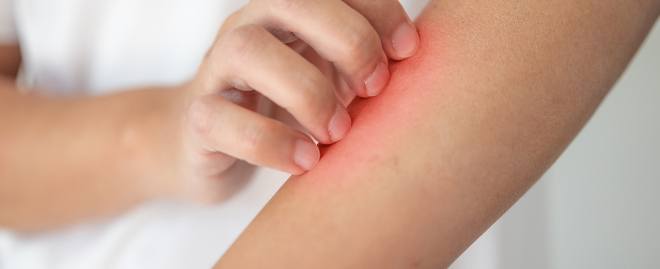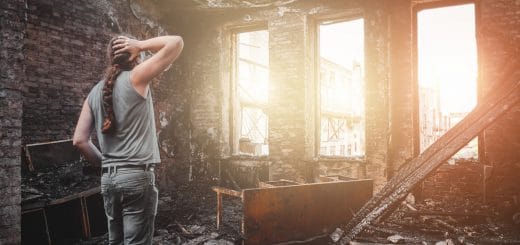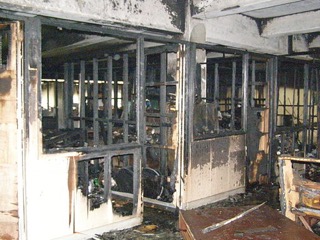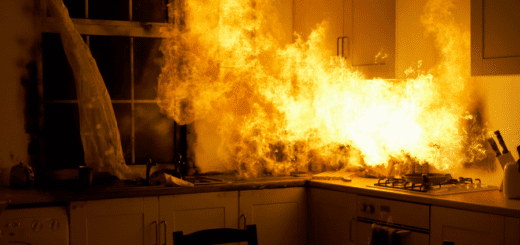How Fire and Smoke Can Damage Your Skin
Smoke from a fire not only causes respiratory issues but also adversely impacts the skin. Issues, such as itchiness and eczema, are not uncommon when individuals remain exposed to smoke. Here’s a closer look at how smoke, a byproduct of fire, can damage a person’s skin.
How common are home fires?
Exposure to smoke and the subsequent skin damage is hardly rare, considering that every year, an average of 358,300 home fires occurs. Most residential fires are sparked by either cooking accidents, heating equipment malfunctions, electrical and lighting equipment, arson, or smoking materials.

What does smoke consist of?
Smoke particles are a byproduct of fire. Smoke consists of solid, liquid, and gas particles and hundreds of different chemicals and fumes. Even though individual smoke particles are too tiny to see, a visible cloud of smoke forms when the particles combine.
Depending on the type of material burned, the smoke released by the flames can be toxic or irritating. Vital organs, such as the heart, lungs, and others, can be negatively affected, especially when an individual is exposed to smoke pollutionPollution is the introduction of harmful substances into the... More for long bouts and inhales the tiny particles.
What skin conditions are triggered by smoke?
In addition to the aforementioned organs, the skin is harmed by smoke pollutionPollution is the introduction of harmful substances into the... More. Skin is the largest and most exposed organ in the human body. It remains continuously exposed to various environmental conditions, including smoke in the aftermath of a home fire.
Itchiness and eczema are two skin conditions oftentimes reported by people who are exposed to smoke pollutionPollution is the introduction of harmful substances into the... More. Atopic dermatitis, also known as eczema, can be experienced even by people who have never been diagnosed with eczema prior to exposure to the smoke.

An individual only needs to be exposed to smoke for a brief period before the skin damage occurs. Short bursts of smoke are known to damage the skin barrier. Smoke pollutionPollution is the introduction of harmful substances into the... More has a quick and dramatic effect and requires immediate medical treatments, such as systemic medications or steroids.
Although it is clear to medical experts that brief exposure to smoke can harm the skin, it is currently not known exactly what type of damage occurs due to prolonged exposure to smoke. However, the closer a person is to the smoke, the more pronounced the skin damage may be.
Check out Is It Safe to Stay in a Smoke Damaged Home?, to learn if your skin can get irritated from the smoke living enviroment.
In what ways does smoke harm the skin?
Smoke particles contain a range of chemicals and gases, many of which penetrate the skin’s outer barrier and damage cells. As a result, gene transcription is disrupted. The smoke particles also trigger oxidative stress or cause inflammation of the skin.
Oxidative stress is the biochemical breakdown that occurs at the cellular level. The structural collagen fibers in the skin become fragmented and weakened. Pigment-producing cells become overactive, creating dark spots. These effects occur as a result of the skin’s protective response to pollutants.
Individuals who had been diagnosed with eczema prior to the smoke exposure already have skin that is susceptible to dryness and inflammation. Additional flare-ups and itchiness develop when people with eczema are exposed to the irritants contained in the smoke particles from a fire.
Even individuals with healthy skin experience itchiness and eczema when exposed to smoke pollutionPollution is the introduction of harmful substances into the... More. In people with normal skin, their skin acts as a barrier against environmental pollutants. However, smoke particles can significantly stress this barrier, leading to symptoms, such as itchiness and eczema.
How do individuals protect their skin from smoke?
Individuals previously diagnosed with atopic dermatitis or who have sensitive skin should be extra careful when fires burn around them. In areas where wildfires occur, for instance, officials warn the general public to stay indoors. Vulnerable people are advised to heed the warning and stay inside.
When going outside, opt to wear protective clothing. Long pants and long-sleeved shirts serve as a layer of fabric protection against contaminants in the air, like smoke particles. Bathe regularly to wash away the toxins that may have adhered to the skin. Wear moisturizer, a protective barrier for the skin.

Eat healthily as a way to defend against smoke’s toxic effects. Choose foods rich in antioxidants, which replenish the body’s natural supply of antioxidants. Brightly colored foods, like peppers, carrots, berries, yams, and dark leafy greens, are good sources of antioxidants.
Another healthy practice that benefits the skin is sleep. Cells repairRepair is the act of fixing or restoring damaged property, m... More themselves during rest. Adults are advised to get a quality night’s sleep of at least seven to nine hours each night. Hydrate well, too. Water is considered to be the ideal beverage, followed by herbal teas and plant milk.
Any worsening of the skin conditions produced by the effects of smoke should be addressed promptly by a medical professional. Individuals who are exposed to smoke and consequently experience itchiness or eczema should make an appointment with a dermatologist and obtain an accurate diagnosis.
While taking care of your health is important after a home fire, so is protecting your property. When you are faced with fire and smoke damage, consult fire damage restoration experts for immediate professional attention. They swiftly restore buildings destroyed by a fire.

Skilled technicians will arrive on-site and begin the restorationRestoration is the process of returning a property to its pr... More process right away. Fire and smoke damage spread rapidly, leading to permanent ruin of household materials if restorationRestoration is the process of returning a property to its pr... More is delayed.
The restorationRestoration is the process of returning a property to its pr... More process includes emergency pre-cleaning, content cleaning, and wall and ceiling cleaning. Safe cleaners are used to minimize damage to delicate surfaces. Content pack-outPack-out is the process of carefully removing and transporti... More and deodorization may also be provided to return the home to a habitable condition.












